"Anatomy" of home acoustic systems: materials and acoustic design
This is a new cycle of posts devoted to acoustic systems. Due to the fact that the topic is extremely extensive, we decided to create a series of articles reflecting the selection criteria when buying a speaker. This post is dedicated to the acoustic properties of the materials of the hull and acoustic design. The post will be especially useful for those who are faced with the choice of speakers, and will also provide information for people who want to create their own speakers in their DIY experiments.
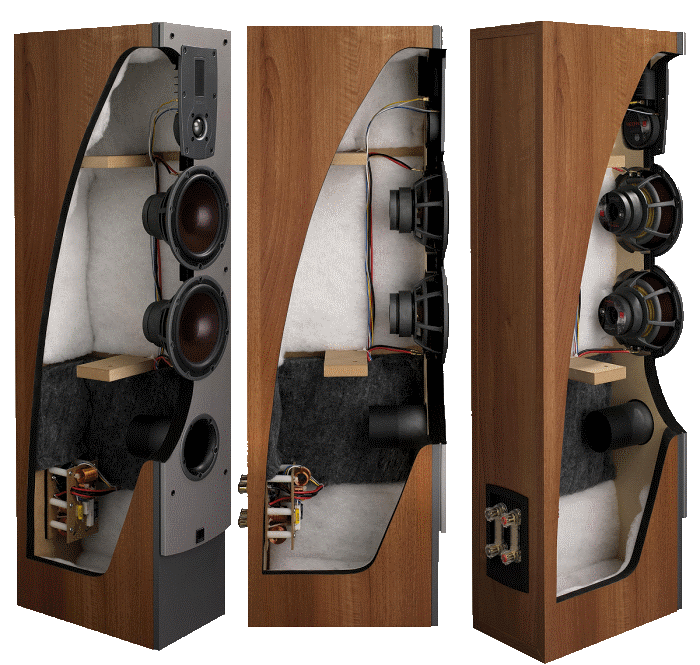
It is believed that one of the decisive factors affecting the sound of speakers, is the body material. PULT experts believe that the value of this factor is often exaggerated, however, it is really important, and it cannot be written off. No less important factor (among many others), determining the sound of the speakers, is the acoustic design.
')
I warn you, the material has links to the goods not as a frank jeans, but as examples (I hope it won't hurt anyone), everything is strictly within the scope of the topic.
Plastic is often used in the manufacture of low cost speakers. The plastic case is light, significantly expands the possibilities of designers, thanks to the casting, you can realize almost any shape. Different types of plastics are very different in their acoustic properties. In the production of high-quality home acoustics, plastic is not very popular, and is in demand for professional designs, where low weight and mobility are important.

With a 90% chance, if you are confronted with home acoustics made of plastic, this is either a budget option for not very sophisticated users, or a sample that is comparable in cost to counterparts from MDF and particleboard. The plastic case of the device of insufficient thickness and density will begin to resonate and rattle when the volume is increased to 60 - 90%. In high-quality speakers, with a calculated thickness and suitable acoustic properties of the material, “parasitic” mid-frequency resonances are minimized; however, the cost of such speakers is almost equal to analogues from other materials. Squeezing out of the budget plastic speaker a deep and adequate bottom will not help even a breathtaking equalization.

A typical representative of the "plastic fraternity" in home acoustics with decent performance and attractive price: Bookshelf speakers JBL Jembe black
Due to its good absorbing properties, wood is considered one of the best materials for the manufacture of columns.
Array and veneer for the production of speakers are used relatively rarely and, as a rule, are in demand in the HI-End segment. Wooden loudspeakers gradually disappear from the market due to low processability, material instability and extremely high cost.
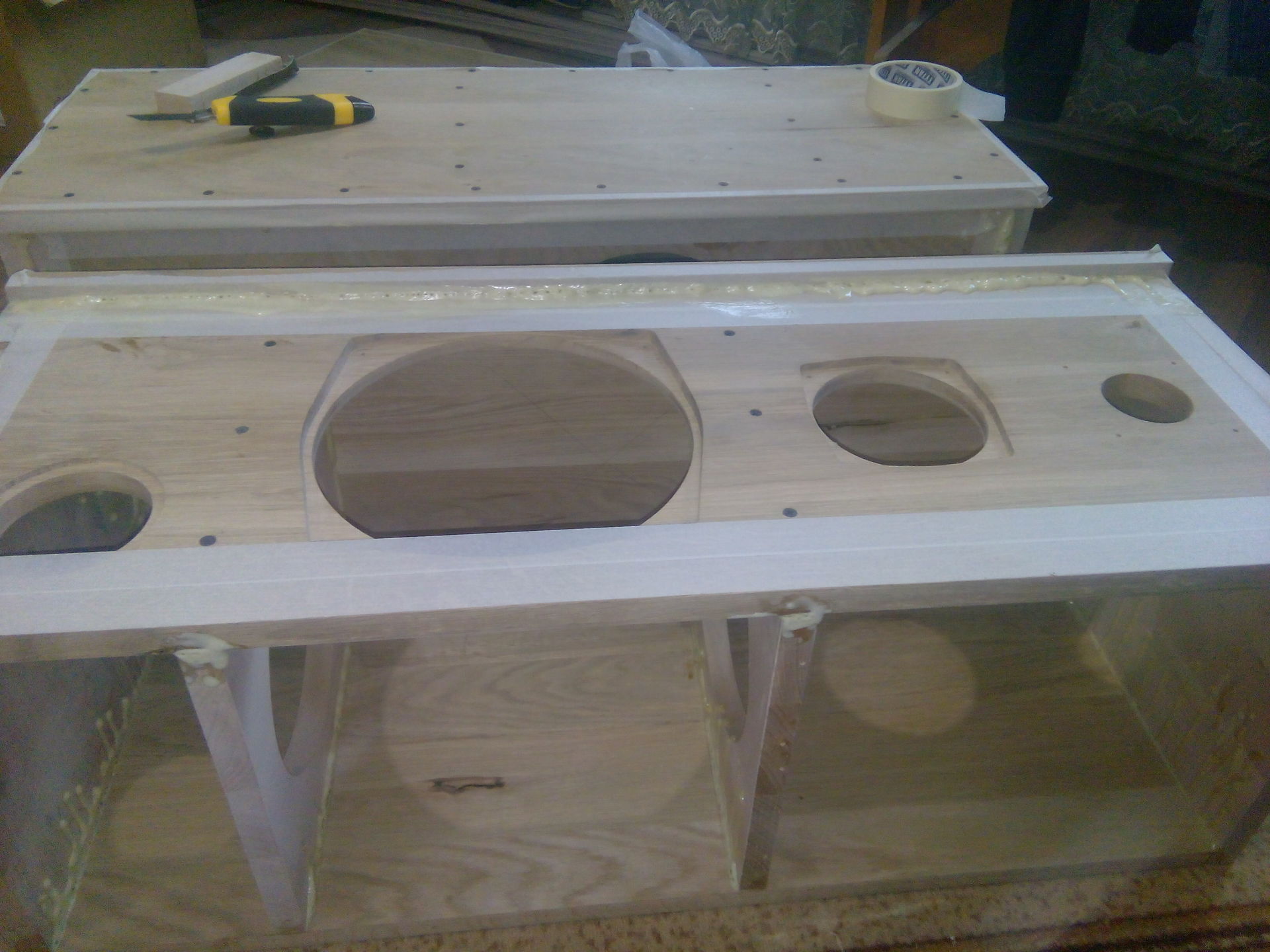
Interestingly, to create truly high-quality speakers of this type, meeting the requirements of the most sophisticated listeners, technologists must select the material at the cutting stage, as in the production of acoustic musical instruments. The latter is related to the properties of wood, where everything is important, starting from the area where the tree grew, ending with the humidity level of the room where it was stored, temperature and duration of drying et cetera. The latter circumstance makes DIY development difficult, in the absence of special knowledge, an amateur who creates a wooden speaker is doomed to act by trial and error.
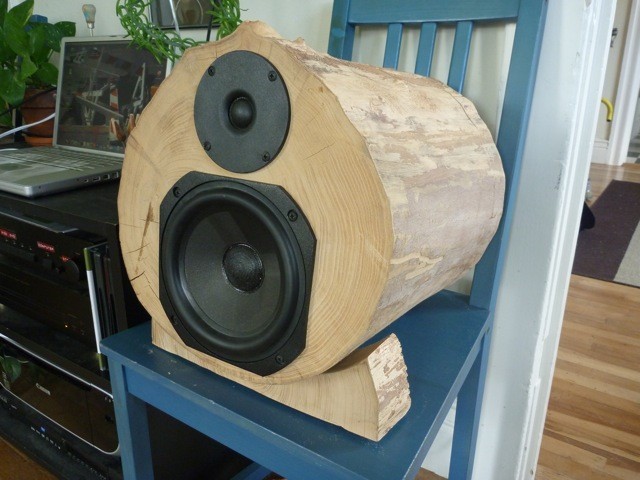
What is the situation in fact, and whether the described conditions are observed, the manufacturers of such acoustics do not report, and accordingly, any wooden system requires careful listening before buying. With a high degree of probability, two speakers of the same model from the same breed will differ slightly in sound, which is especially important for some discerning listenerswith golden ears with big money.
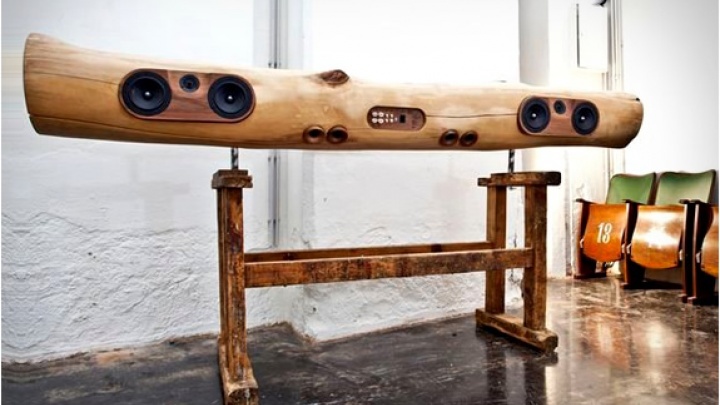
Available columns from the array of valuable breeds units, the cost of their astronomical. Everything that your humble servant has heard, sounds excellent. However, in my subjectively-pragmatic view, disproportionately cost. Sometimes, well-designed cases made of plywood and MDF have no less musicality, but for many audiophiles “not wood” = “not true hi-end”, and for someone “not wood” simply does not allow status or interior design spoils.
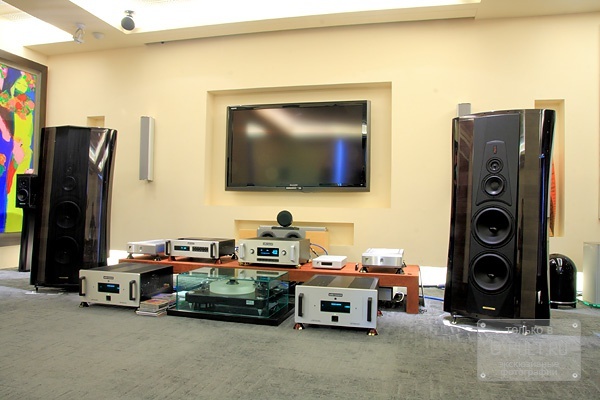
I believe that one of the best wooden systems in our catalog is this:
Outdoor speakers Sonus Faber Stradivari Homage graphite (price corresponding)
Plywood, used for the production of acoustic enclosures, has from 10 to 14 layers and is almost as good as acoustic properties, in particular, sound absorption, while it is somewhat cheaper than wood, more technological during processing, lighter than particle board and MDF. Laminated plywood well absorbs unwanted vibrations due to the structure of the material.
Like wood - plywood is used in fairly expensive, and sometimes in elite piece products. The cost of plywood speakers is not much lower than those produced from an array, and is quite comparable with them in quality.
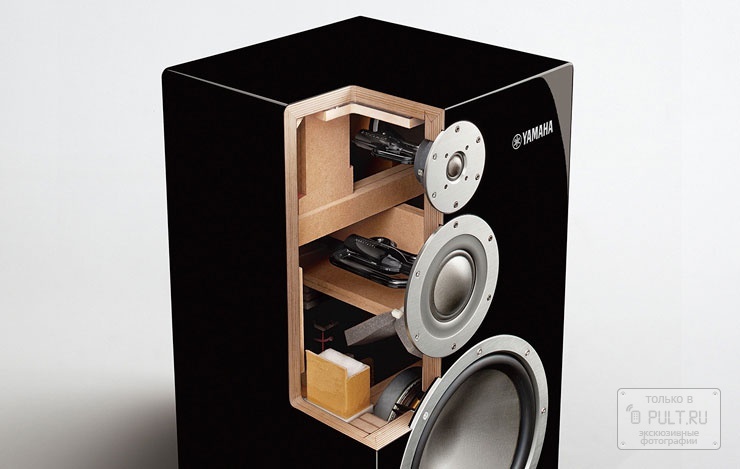
In some cases, the body, declared by the manufacturer as "plywood", made of chipboard and MDF. Therefore, low prices for speakers with plywood or wooden casing should be alerted. A number of small Asian manufacturers, who regularly change their names and sell mostly in the network, create combined cases, including several small but noticeable plywood (wooden) elements, and the main part is made of chipboard.
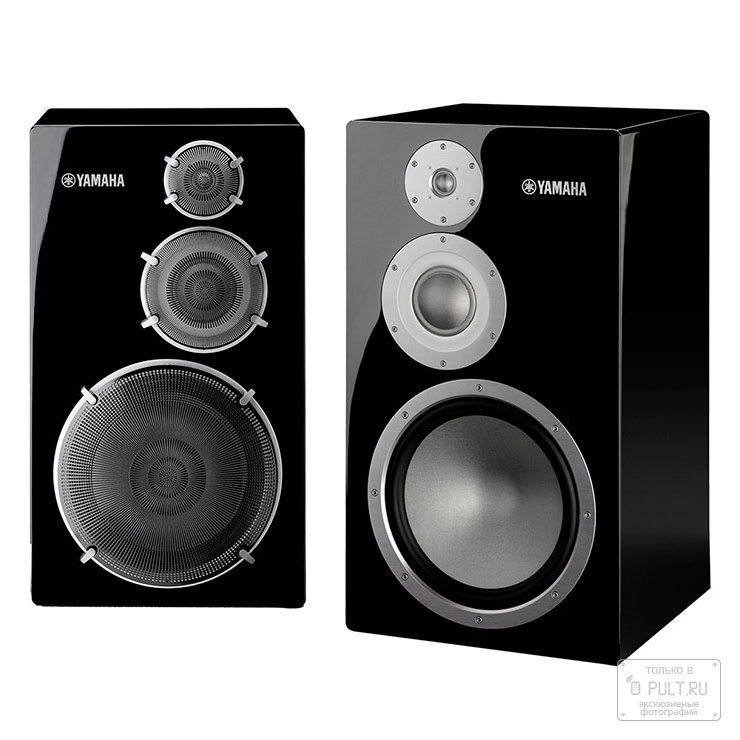
Among the speakers created from plywood, I can highlight this: bookshelf speakers Yamaha NS-5000
The chipboard board is comparable in price to plastic, but it does not have a number of drawbacks that are inherent in plastic cases. The most significant problem of chipboard is low strength, with a sufficiently high mass of material.
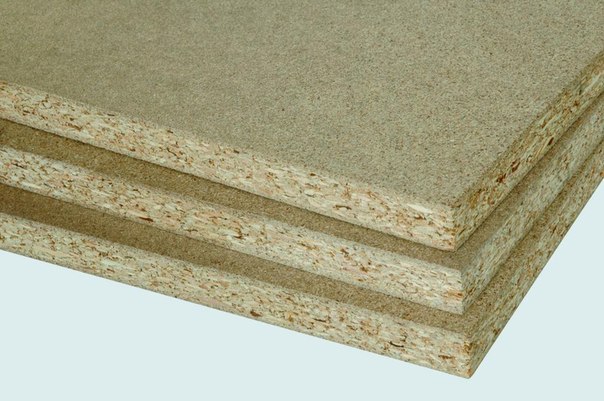
Sound absorption in particleboard is non-uniform and in some cases low and medium frequency resonances may occur, although the probability of their appearance is lower than that of plastic. Effectively quench resonances can slabs with a thickness of more than 16 mm, which reach the required density. It should be noted that, as in the case of plastic, the properties of a particular chipboard is of great importance. It is important to take into account the density and humidity of the material, since different chipboard plates differ in these parameters. Not infrequently thick, dense chipboard plates are used to create studio monitors, which indicates the demand for material in the production of professional equipment.
Note, for comrades from the DIY brothers, a chipboard with a density of at least 650–820 kg / m³ (with a plate thickness of 16–18 mm) and a moisture content of no more than 6–7% is well suited for creating speakers. Failure to comply with these conditions will significantly affect the sound quality and reliability of the speakers.
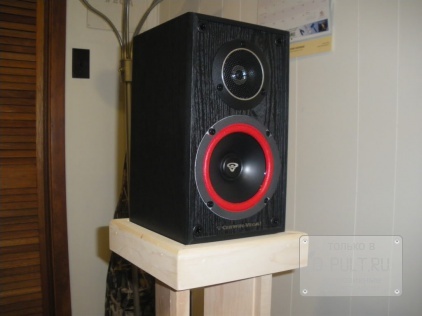
Among the worthy DSP options for home speakers, our experts point out: Cerwin-Vega SL-5M
Today MDF (Medium Density Fiberboard, medium density fiberboard) is used everywhere, among other things, MDF is one of the most common modern materials for the production of acoustics.
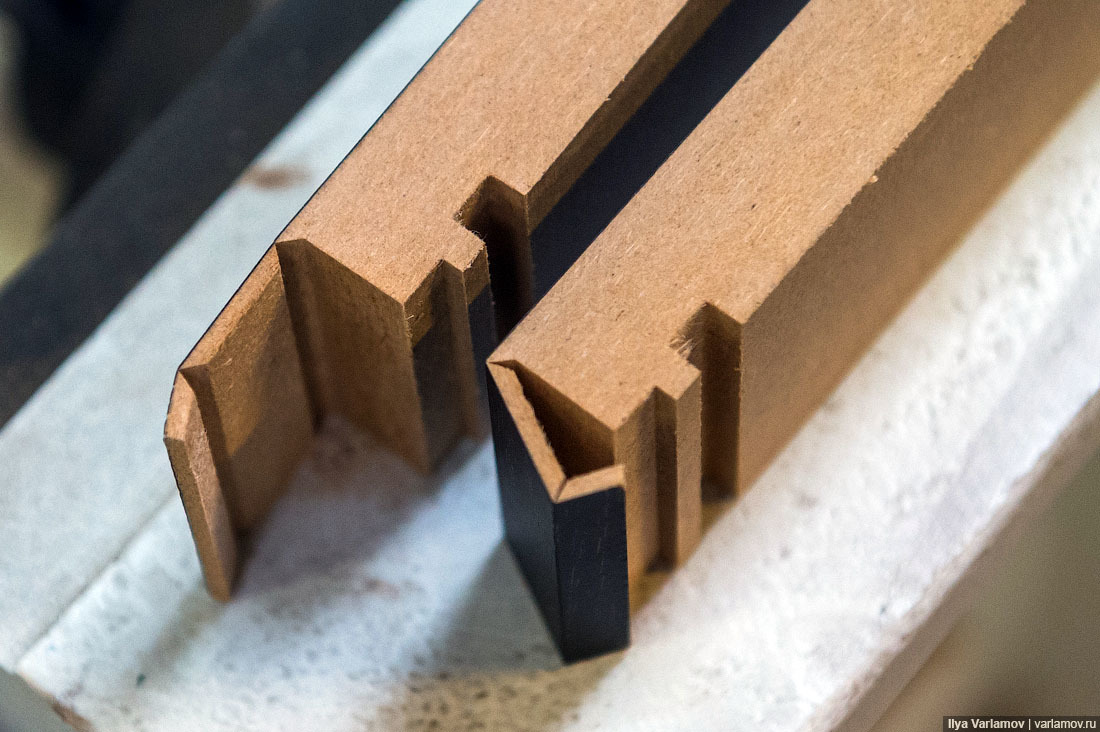
The reason for the popularity of MDF were the physical properties of the material, namely:
The material is cheap in production, has acoustic properties comparable to the characteristics of wood, while the resistance of the plates to mechanical damage is somewhat higher. MDF has sufficient acoustic rigidity of the speaker enclosure, and sound absorption corresponds to the parameters necessary to create HI-FI acoustics.

Visual difference between MDF and particleboard

Among the MDF acoustics, the mass of remarkable systems, in my opinion, optimal in terms of price / quality ratio are the following:
→ Yamaha NS-BP182 piano black - shelf
→ Focal Chorus 726 - Outdoor
The most common metal in the production of speakers is aluminum, as well as alloys based on it. Some authors and experts believe that the aluminum case can reduce resonances, as well as improve the transmission of high frequencies. The sound absorption coefficient of aluminum alloys is not high, and is about 0.05, which, however, is significantly better than that of steel. Manufacturers use sandwich panels to reduce vibration, improve sound absorption and prevent harmful resonances, where a layer of high molecular weight polyethylene resins or other low-density materials, such as viscoelastic, is placed between 2 aluminum sheets.

In the case of low-cost aluminum speakers, manufacturers, not infrequently, rely on the design, to the detriment of the sound: as a result, the acoustic characteristics leave much to be desired. Sometimes users of such acoustics complain of a hard, distorted sound caused by insufficient sound absorption of the case. Due to the fact that the waves are well reflected and poorly absorbed, an accurate calculation of the hull design, selection of emitters, used filters, as well as the quality of the connections of individual parts are very important in metallic acoustics.
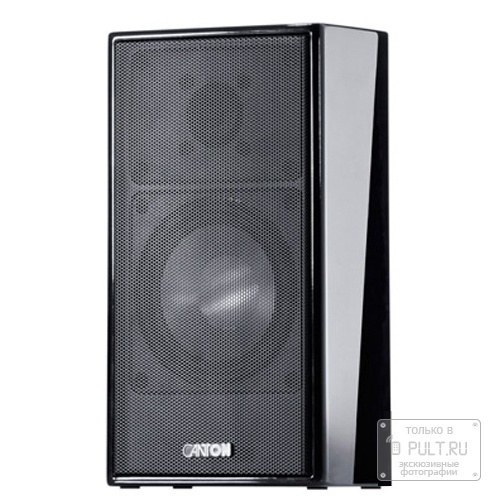
Among the decently sounding aluminum speakers I was especially impressed by the sound:
→ Canton CD 310 white high gloss (price is impressive, but not exorbitant)
Stone is one of the most expensive materials for the production of acoustic enclosures. The immaculate reflection and the practical impossibility of the appearance of vibrational resonances make these materials in demand among especially demanding listeners.

Most rocks have a stable sound absorption coefficient, which, for example, for granite, is 0.130 for the entire spectrum of sound frequencies, and for limestone, 0.264. Manufacturers especially appreciate the porous rocks of the stone, in which the higher sound absorption.
The use of stone slabs for making DIY acoustics is almost impossible, since it requires not only remarkable knowledge in acoustics and stone processing, but also extremely expensive equipment (no one has yet produced home 3-D stone cutters for stone).
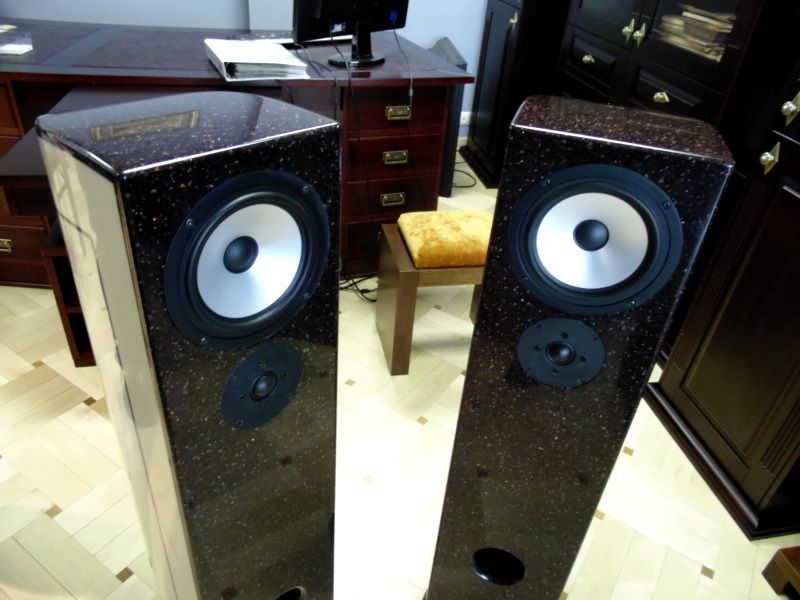
For the production of serial speakers used rocks such as granite, marble, slate, limestone, basalt. These breeds have similar acoustic properties, and with appropriate processing they become real works of art. It is not uncommon for stone buildings to be used to create landscape acoustics, in such cases a cavity is created in the untreated stone to accommodate the radiator in which the fastening elements are installed (as a rule, it is made to order).
The stone has 2 main problems: cost and mass. The price of a stone speaker can be higher than any other with similar characteristics. The mass of some samples of floor systems can reach 40 kg or more.
The original solution is the creation of speakers from glass. Only two companies, Waterfall and SONY, have so far succeeded in this business. The material is interesting from a design point of view, acoustically glass creates certain problems, mainly in the form of resonances, which the above companies have learned to solve, there are even reference options.
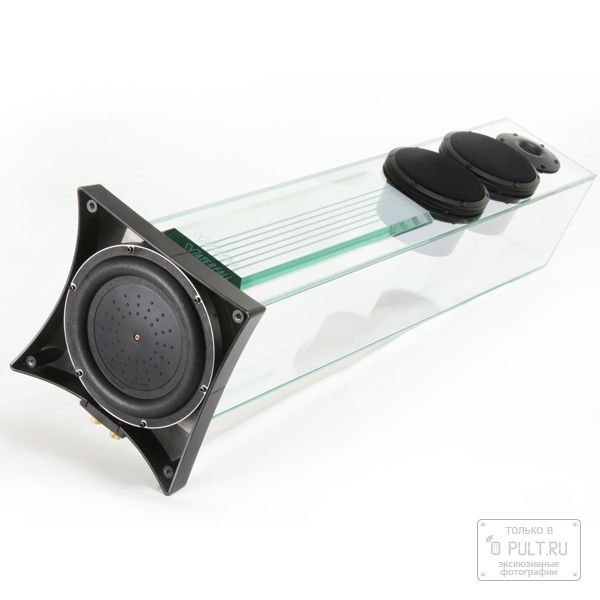
Prices for a transparent miracle are also difficult to call democratic, the latter is associated with low manufacturability and high production costs.
From the impressive glass samples I can recommend: Waterfall Victoria Evo
No less important for accurate sound transmission in speakers has acoustic design. I will talk about the most common types (naturally, these or other types can be combined depending on the specific model, for example, the phase inverted part of the column is responsible for the low and mid-frequency range, and for the high horn it is built).
Phase inverter - one of the most common types of acoustic design. This method allows, with the correct calculation of the length of the pipe, the cross-section of the opening and the volume of the body, to obtain a high efficiency, an optimal ratio of frequencies, to strengthen low ones. The essence of the phase inverter principle is that a hole with a pipe is placed on the back of the case, which allows you to create low-frequency oscillations in-phase waves created by the front side of the diffuser. Most often the phase inverter type is used to create 2.0 and 4.0 systems.
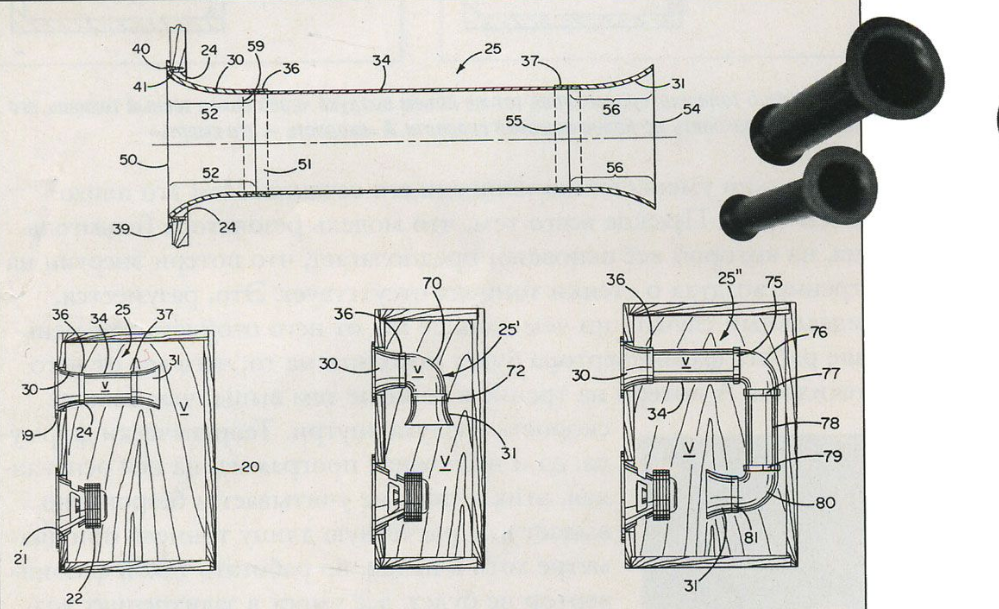
To facilitate calculations when creating your own speakers, it is convenient to use special calculators, one of the convenient ones is listed here .
In the HI-END philosophy, there are extremely radical uncompromising judgments about phase inverter systems; I quote one of them without comment:
The classic option for many manufacturers - the usual closed box, with raised to the surface of the speaker cone. This type of acoustics is quite simple for calculations, and the efficiency of such devices does not shine. Also, the boxes do not recommend lovers that are typically pronounced low, as in a closed system without additional elements that can enhance the lower levels (bass reflex, resonator), the frequency spectrum from 20 to 350 Hz is weakly expressed.
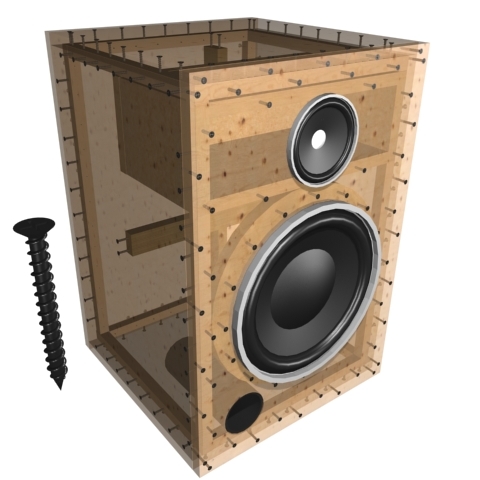
Many music lovers prefer a closed type, as it is characterized by a relatively flat frequency response and realistic "fair" transfer of reproduced musical material. Most studio monitors are created in this acoustic design.
Band-Pass was extended when creating subwoofers. In this type of acoustic design, the emitter is hidden inside the case, while the inside of the box is connected to the external environment by phase inverter pipes. The task of the emitter is the excitation of low-frequency oscillations, the amplitude of which multiply increases due to phase inverter tubes.
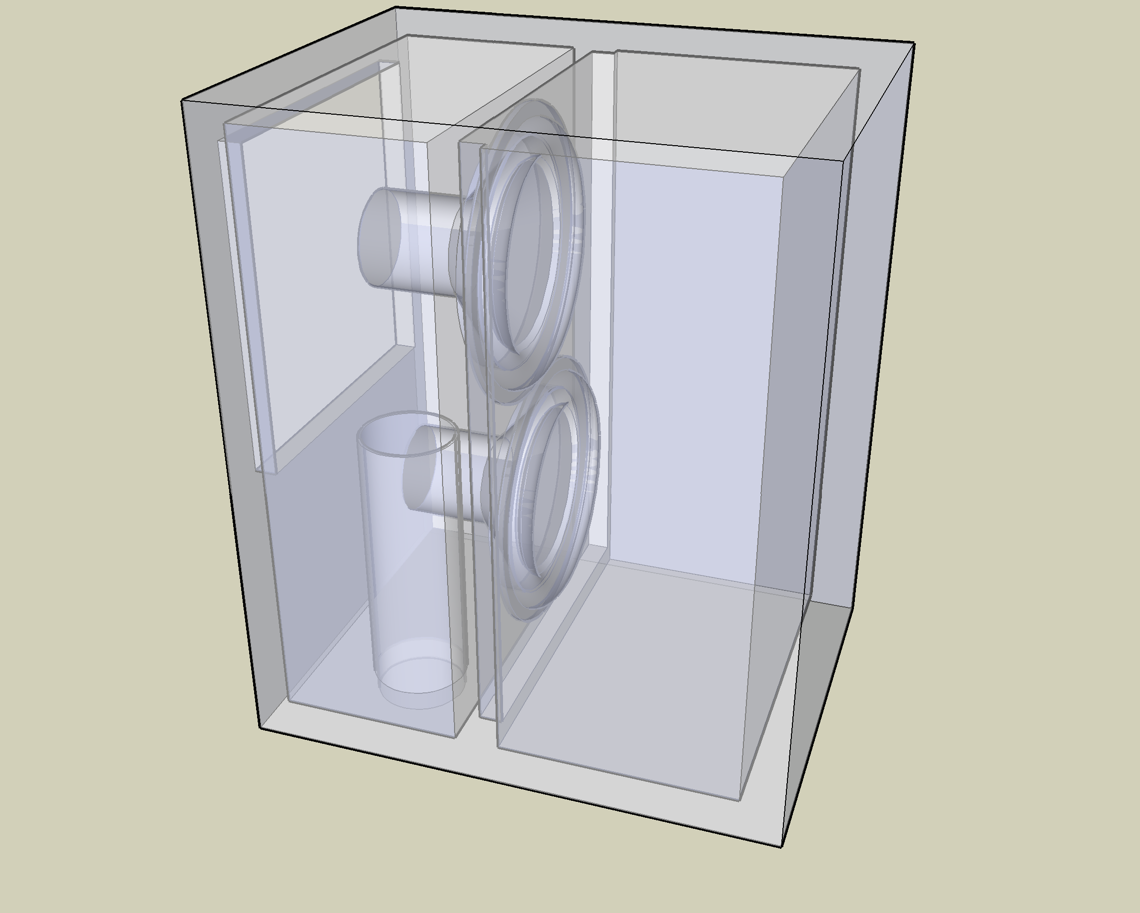
With a properly designed construction of this type, such parasitic echoes as low humming, hum, etc. should not occur, which is often the case for budget systems of this type.
A relatively rare type of acoustic design today, in which the rear wall of the case is repeatedly perforated, or completely absent. This type of design is used in order to reduce the number of chassis elements that affect the frequency response of the speakers.
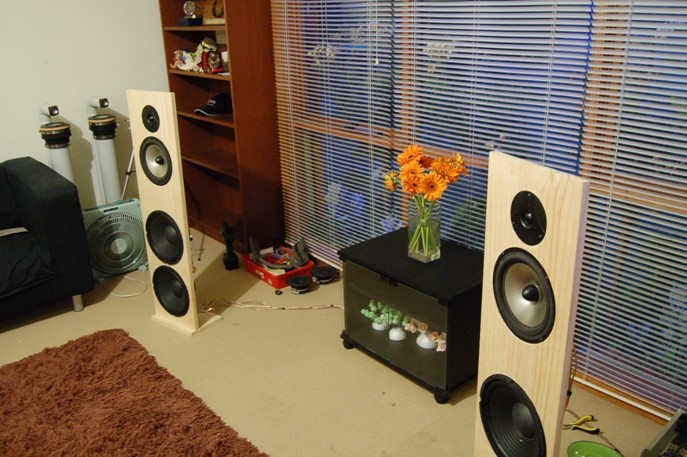
In an open box, the front wall has the most significant effect on sound, which reduces the likelihood of distortion from the rest of the case. The contribution of the side walls (if they are present in the structure), when they are not wide, is minimal and is no more than 1-2 dB.
Horn acoustic design is often used in combination with other types (in particular for the design of high-frequency emitters), however, there are also 100% original horn constructions.
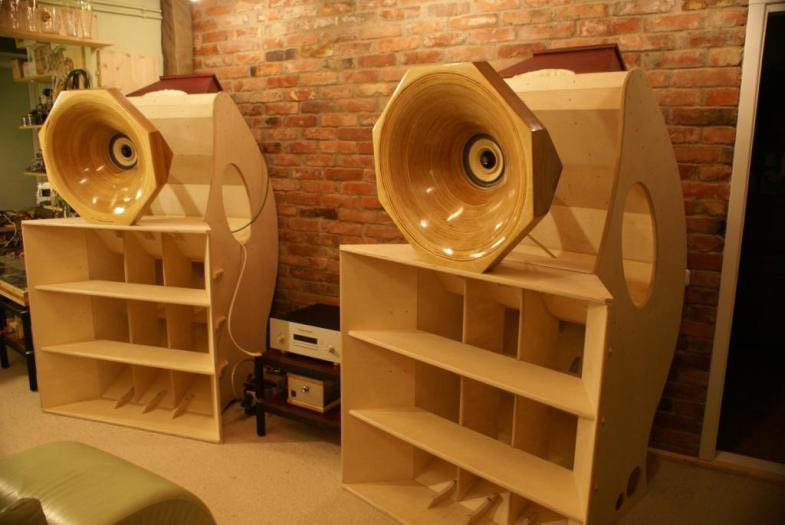
The main advantage of horn speakers is high volume, when combined with sensitive speakers.
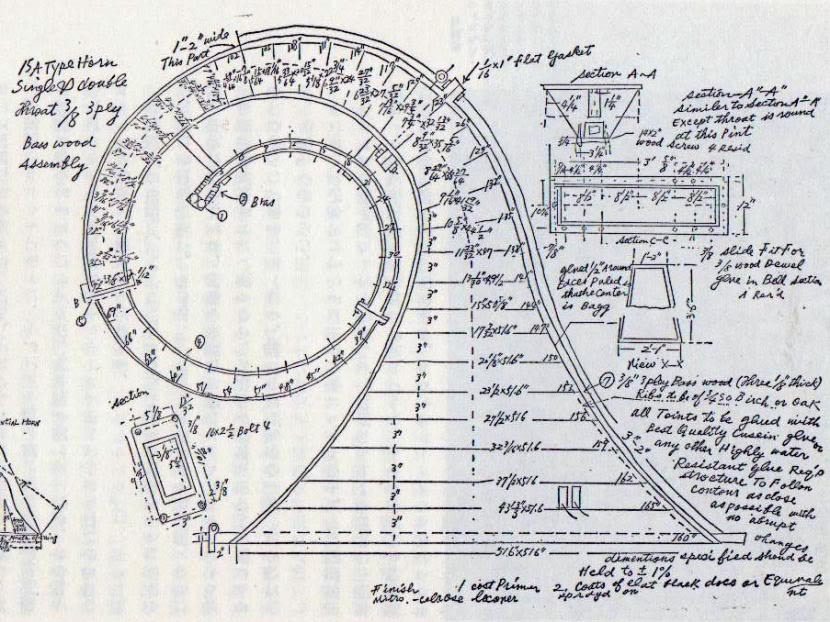
Most experts are skeptical of horn acoustics, there are several reasons:
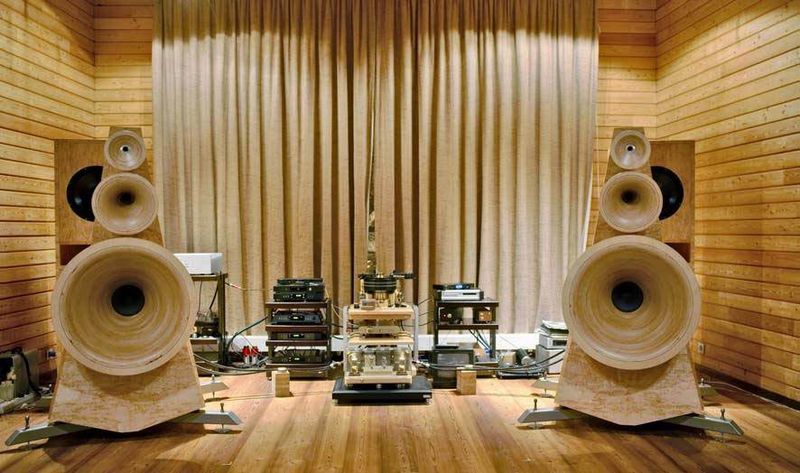
Horn systems became the most popular among the audiophiles who are in search of a “divine” sound. The biased approach allowed the archaic horn design to get a second life, and modern manufacturers were able to find original solutions (effective, but extremely expensive) of common horn problems.
That's all for now. Continuation, as usual, follows, and the “opening” will definitely show ... I announce the future: emitters, power / sensitivity / volume of the room.

It is believed that one of the decisive factors affecting the sound of speakers, is the body material. PULT experts believe that the value of this factor is often exaggerated, however, it is really important, and it cannot be written off. No less important factor (among many others), determining the sound of the speakers, is the acoustic design.
')
I warn you, the material has links to the goods not as a frank jeans, but as examples (I hope it won't hurt anyone), everything is strictly within the scope of the topic.
Material: from plastic to granite and glass
Plastic - cheap, angry, but resonates
Plastic is often used in the manufacture of low cost speakers. The plastic case is light, significantly expands the possibilities of designers, thanks to the casting, you can realize almost any shape. Different types of plastics are very different in their acoustic properties. In the production of high-quality home acoustics, plastic is not very popular, and is in demand for professional designs, where low weight and mobility are important.
(for most plastics, the sound absorption coefficient ranges from 0.02 to 0.03 at 125 Hz to 0.05 to 0.06 at 4 kHz)

With a 90% chance, if you are confronted with home acoustics made of plastic, this is either a budget option for not very sophisticated users, or a sample that is comparable in cost to counterparts from MDF and particleboard. The plastic case of the device of insufficient thickness and density will begin to resonate and rattle when the volume is increased to 60 - 90%. In high-quality speakers, with a calculated thickness and suitable acoustic properties of the material, “parasitic” mid-frequency resonances are minimized; however, the cost of such speakers is almost equal to analogues from other materials. Squeezing out of the budget plastic speaker a deep and adequate bottom will not help even a breathtaking equalization.

A typical representative of the "plastic fraternity" in home acoustics with decent performance and attractive price: Bookshelf speakers JBL Jembe black
Tree - from cutting down to golden ears
Due to its good absorbing properties, wood is considered one of the best materials for the manufacture of columns.
(the sound absorption coefficient of wood, depending on the breed is from 0.15 - 0.17 at 125 Hz to 0.09 at 4 kHz)
Array and veneer for the production of speakers are used relatively rarely and, as a rule, are in demand in the HI-End segment. Wooden loudspeakers gradually disappear from the market due to low processability, material instability and extremely high cost.

Interestingly, to create truly high-quality speakers of this type, meeting the requirements of the most sophisticated listeners, technologists must select the material at the cutting stage, as in the production of acoustic musical instruments. The latter is related to the properties of wood, where everything is important, starting from the area where the tree grew, ending with the humidity level of the room where it was stored, temperature and duration of drying et cetera. The latter circumstance makes DIY development difficult, in the absence of special knowledge, an amateur who creates a wooden speaker is doomed to act by trial and error.

What is the situation in fact, and whether the described conditions are observed, the manufacturers of such acoustics do not report, and accordingly, any wooden system requires careful listening before buying. With a high degree of probability, two speakers of the same model from the same breed will differ slightly in sound, which is especially important for some discerning listeners

Available columns from the array of valuable breeds units, the cost of their astronomical. Everything that your humble servant has heard, sounds excellent. However, in my subjectively-pragmatic view, disproportionately cost. Sometimes, well-designed cases made of plywood and MDF have no less musicality, but for many audiophiles “not wood” = “not true hi-end”, and for someone “not wood” simply does not allow status or interior design spoils.

I believe that one of the best wooden systems in our catalog is this:
Outdoor speakers Sonus Faber Stradivari Homage graphite (price corresponding)
Plywood - almost a tree, if not flown over Beijing
Plywood, used for the production of acoustic enclosures, has from 10 to 14 layers and is almost as good as acoustic properties, in particular, sound absorption, while it is somewhat cheaper than wood, more technological during processing, lighter than particle board and MDF. Laminated plywood well absorbs unwanted vibrations due to the structure of the material.
(sound absorption coefficient of 12-layer plywood is from 0.1–0.2 at 125 Hz to 0.07 at 4 kHz)
Like wood - plywood is used in fairly expensive, and sometimes in elite piece products. The cost of plywood speakers is not much lower than those produced from an array, and is quite comparable with them in quality.

In some cases, the body, declared by the manufacturer as "plywood", made of chipboard and MDF. Therefore, low prices for speakers with plywood or wooden casing should be alerted. A number of small Asian manufacturers, who regularly change their names and sell mostly in the network, create combined cases, including several small but noticeable plywood (wooden) elements, and the main part is made of chipboard.

Among the speakers created from plywood, I can highlight this: bookshelf speakers Yamaha NS-5000
Chipboard - thickness, density, humidity
The chipboard board is comparable in price to plastic, but it does not have a number of drawbacks that are inherent in plastic cases. The most significant problem of chipboard is low strength, with a sufficiently high mass of material.

Sound absorption in particleboard is non-uniform and in some cases low and medium frequency resonances may occur, although the probability of their appearance is lower than that of plastic. Effectively quench resonances can slabs with a thickness of more than 16 mm, which reach the required density. It should be noted that, as in the case of plastic, the properties of a particular chipboard is of great importance. It is important to take into account the density and humidity of the material, since different chipboard plates differ in these parameters. Not infrequently thick, dense chipboard plates are used to create studio monitors, which indicates the demand for material in the production of professional equipment.
Note, for comrades from the DIY brothers, a chipboard with a density of at least 650–820 kg / m³ (with a plate thickness of 16–18 mm) and a moisture content of no more than 6–7% is well suited for creating speakers. Failure to comply with these conditions will significantly affect the sound quality and reliability of the speakers.

Among the worthy DSP options for home speakers, our experts point out: Cerwin-Vega SL-5M
MDF: from furniture to acoustics
Today MDF (Medium Density Fiberboard, medium density fiberboard) is used everywhere, among other things, MDF is one of the most common modern materials for the production of acoustics.

The reason for the popularity of MDF were the physical properties of the material, namely:
- Density 700 - 800 kg / m³
- Sound absorption coefficient 0.15 at 125 Hz - 0.09 at 4 kHz
- Humidity 1-3%
- Mechanical strength and wear resistance
The material is cheap in production, has acoustic properties comparable to the characteristics of wood, while the resistance of the plates to mechanical damage is somewhat higher. MDF has sufficient acoustic rigidity of the speaker enclosure, and sound absorption corresponds to the parameters necessary to create HI-FI acoustics.

Visual difference between MDF and particleboard

Among the MDF acoustics, the mass of remarkable systems, in my opinion, optimal in terms of price / quality ratio are the following:
→ Yamaha NS-BP182 piano black - shelf
→ Focal Chorus 726 - Outdoor
Aluminum alloys - design and accurate calculations
The most common metal in the production of speakers is aluminum, as well as alloys based on it. Some authors and experts believe that the aluminum case can reduce resonances, as well as improve the transmission of high frequencies. The sound absorption coefficient of aluminum alloys is not high, and is about 0.05, which, however, is significantly better than that of steel. Manufacturers use sandwich panels to reduce vibration, improve sound absorption and prevent harmful resonances, where a layer of high molecular weight polyethylene resins or other low-density materials, such as viscoelastic, is placed between 2 aluminum sheets.

In the case of low-cost aluminum speakers, manufacturers, not infrequently, rely on the design, to the detriment of the sound: as a result, the acoustic characteristics leave much to be desired. Sometimes users of such acoustics complain of a hard, distorted sound caused by insufficient sound absorption of the case. Due to the fact that the waves are well reflected and poorly absorbed, an accurate calculation of the hull design, selection of emitters, used filters, as well as the quality of the connections of individual parts are very important in metallic acoustics.

Among the decently sounding aluminum speakers I was especially impressed by the sound:
→ Canton CD 310 white high gloss (price is impressive, but not exorbitant)
Stone - granite slabs for the price of gold bars
Stone is one of the most expensive materials for the production of acoustic enclosures. The immaculate reflection and the practical impossibility of the appearance of vibrational resonances make these materials in demand among especially demanding listeners.

Most rocks have a stable sound absorption coefficient, which, for example, for granite, is 0.130 for the entire spectrum of sound frequencies, and for limestone, 0.264. Manufacturers especially appreciate the porous rocks of the stone, in which the higher sound absorption.
The use of stone slabs for making DIY acoustics is almost impossible, since it requires not only remarkable knowledge in acoustics and stone processing, but also extremely expensive equipment (no one has yet produced home 3-D stone cutters for stone).

For the production of serial speakers used rocks such as granite, marble, slate, limestone, basalt. These breeds have similar acoustic properties, and with appropriate processing they become real works of art. It is not uncommon for stone buildings to be used to create landscape acoustics, in such cases a cavity is created in the untreated stone to accommodate the radiator in which the fastening elements are installed (as a rule, it is made to order).
The stone has 2 main problems: cost and mass. The price of a stone speaker can be higher than any other with similar characteristics. The mass of some samples of floor systems can reach 40 kg or more.
Glass transparency and sound quality
The original solution is the creation of speakers from glass. Only two companies, Waterfall and SONY, have so far succeeded in this business. The material is interesting from a design point of view, acoustically glass creates certain problems, mainly in the form of resonances, which the above companies have learned to solve, there are even reference options.

Prices for a transparent miracle are also difficult to call democratic, the latter is associated with low manufacturability and high production costs.
From the impressive glass samples I can recommend: Waterfall Victoria Evo
Acoustic design - boxes, tubes and horns
No less important for accurate sound transmission in speakers has acoustic design. I will talk about the most common types (naturally, these or other types can be combined depending on the specific model, for example, the phase inverted part of the column is responsible for the low and mid-frequency range, and for the high horn it is built).
The phase inverter - the main pipe length
Phase inverter - one of the most common types of acoustic design. This method allows, with the correct calculation of the length of the pipe, the cross-section of the opening and the volume of the body, to obtain a high efficiency, an optimal ratio of frequencies, to strengthen low ones. The essence of the phase inverter principle is that a hole with a pipe is placed on the back of the case, which allows you to create low-frequency oscillations in-phase waves created by the front side of the diffuser. Most often the phase inverter type is used to create 2.0 and 4.0 systems.

To facilitate calculations when creating your own speakers, it is convenient to use special calculators, one of the convenient ones is listed here .
In the HI-END philosophy, there are extremely radical uncompromising judgments about phase inverter systems; I quote one of them without comment:
“Enemy No. 1 is, of course, non-linear amplifying elements in the sound path (further, each person, to the best of education, understands which elements are more linear and which are less). Enemy number 2 is a phase inverter. phase inverter is designed to splurge, should allow a small cheap column to write in the passport 50 ... 40 ... 30, and that little things even 20 Hz in terms of -3 dB! But the lower frequency band of the phase inverter ceases to be related to music, to be more precise, the phase inverter itself is a pipe singing its own melody. ”
Closed box - a coffin for extra low
The classic option for many manufacturers - the usual closed box, with raised to the surface of the speaker cone. This type of acoustics is quite simple for calculations, and the efficiency of such devices does not shine. Also, the boxes do not recommend lovers that are typically pronounced low, as in a closed system without additional elements that can enhance the lower levels (bass reflex, resonator), the frequency spectrum from 20 to 350 Hz is weakly expressed.

Many music lovers prefer a closed type, as it is characterized by a relatively flat frequency response and realistic "fair" transfer of reproduced musical material. Most studio monitors are created in this acoustic design.
Band-Pass (closed box-resonator) - the main thing is not to hum
Band-Pass was extended when creating subwoofers. In this type of acoustic design, the emitter is hidden inside the case, while the inside of the box is connected to the external environment by phase inverter pipes. The task of the emitter is the excitation of low-frequency oscillations, the amplitude of which multiply increases due to phase inverter tubes.

With a properly designed construction of this type, such parasitic echoes as low humming, hum, etc. should not occur, which is often the case for budget systems of this type.
Open enclosure - no extra walls
A relatively rare type of acoustic design today, in which the rear wall of the case is repeatedly perforated, or completely absent. This type of design is used in order to reduce the number of chassis elements that affect the frequency response of the speakers.

In an open box, the front wall has the most significant effect on sound, which reduces the likelihood of distortion from the rest of the case. The contribution of the side walls (if they are present in the structure), when they are not wide, is minimal and is no more than 1-2 dB.
Horn design - problematic champions in volume
Horn acoustic design is often used in combination with other types (in particular for the design of high-frequency emitters), however, there are also 100% original horn constructions.

The main advantage of horn speakers is high volume, when combined with sensitive speakers.

Most experts are skeptical of horn acoustics, there are several reasons:
- Constructive and technological complexity, and, accordingly, high assembly requirements
- It is almost impossible to create a horn speaker with a uniform frequency response (except for devices costing from 10 kilobax and above)
- Due to the fact that the horn is not a resonating system, it is impossible to correct the frequency response (minus for the DIY people who intend to copy the Hi-end horn)
- Due to the peculiarities of the horn acoustical waveform, the volume of the sound is quite low
- Overwhelmingly relatively low dynamic range
- Gives a large number of characteristic overtones (some audiophiles are considered dignity).

Horn systems became the most popular among the audiophiles who are in search of a “divine” sound. The biased approach allowed the archaic horn design to get a second life, and modern manufacturers were able to find original solutions (effective, but extremely expensive) of common horn problems.
That's all for now. Continuation, as usual, follows, and the “opening” will definitely show ... I announce the future: emitters, power / sensitivity / volume of the room.
Source: https://habr.com/ru/post/401825/
All Articles